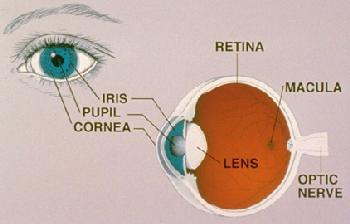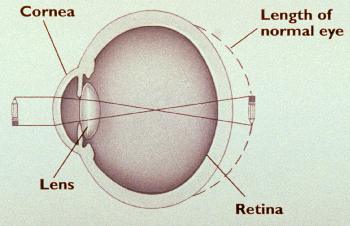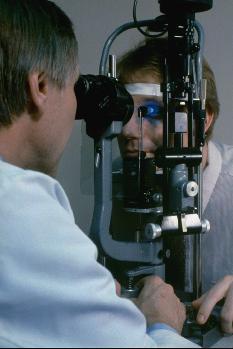|
Welcome To The
Caplan Eye Clinic: Eye Care Library
You will find some common eye-care terms defined below and some general information regarding eye diseases and conditions. This information is provided for educational purposes. It is not intended for self-diagnosis, self-treatment, or to replace professional medical care.
"Anatomy of the Human Eye"

Click on any of the following the topics to view an
explanation.
Astigmatism;
Myopia;
Hyperopia;
Blepharitis;
Cataracts;Chalazion;
Conjunctivitis;
Allergic Conjunctivitis;
Dry Eyes;
Glaucoma;
Macular Degeneration;
Spots & Floaters;
Stye.
Common Eye Conditions

Astigmatism: Astigmatism
is one of several eye conditions known as refractive errors. Refractive
errors are those that deal with the angle at which the light enters the
eye. This effects the focus of the light on the retina, the nerve that
interprets the light into images for the brain.
An astigmatism usually results from an irregular curvature of the cornea
, the front surface of the eye. It is not a disease, and is actually a
common problem. It can cause a blurring or both distant and nearby objects.
This blurred vision can cause headache, fatigue, squinting, and eye
discomfort or irritation.

Myopia: Myopia
is also known as nearsightedness. An individual
with myopia can see items upclose very well, but has difficulty seeing
distant objects. This condition occurs either because the eyeball is
elongated rather than rounded or the cornea's angle of curvature is too
steep. This results in nearsightedness. Instead of the image being focused
to a fine point in the back of the eye, the light comes to a focus in
front of the retina.
Myopia is not a disease. It is a normal variation in the shape of the eye
that is experienced by many individuals. The condition usually begins
between the ages of eight and twelve and nearly always before the age of
twenty. The development of myopia tracks the rapid growth of the human
body during adolescence and pre-adolescence. If the variation is great,
glasses or contact lenses can be used to correct the distorted vision.

Hyperopia: Hyperopia,
or farsightedness, is another type of refractive error.
A farsighted person can see distant objects very well, but has difficulty
seeing items upclose. After viewing nearby items for a long time, a
farsighted person may experience blurred vision, and
irritability. Simple eye exams such as reading an eye chart can miss
Hyperopia since individuals with this condition can see the distant chart
very well. A more extensive eye exam is needed.
In most cases, a person experiencing farsightedness has a compressed
eyeball rather than a rounded one. This causes the light entering the eye
to be focused behind the wall at the rear of the eyeball. The condition
may also be caused by the cornea having too flat of an angle.
Hyperopia is generally thought to be an inherited condition, although
other factors may contribute to it. It is not a disease. If the variation
is slight, an individual's vision might not need correction. If it is
great, however, glasses or contact lenses can be used to correct the
condition.
Common Eye Disorders
Blepharitis: A
common and persistent inflammation of the eyelids frequently occurring in
people with oily skin, dandruff, or dry eyes. Symptoms include irritation,
itching, dandruff-like flaking along the lashes and eyelids, and
occasionally a red eye. While everyone's skin has bacteria on its surface,
in certain individuals the bacteria thrives at the base of the eye lashes.
Blepharitis can be a stubborn condition. While there is no cure, it can be
controlled through simple treatment at home. For more information, consult
your ophthalmologist.

Cataracts: Cataract
is a condition that causes a loss of transparency in the lens of the eye.
This "cloudiness" causes a loss of light entering the eye and
results in "foggy vision". Cataracts are most common in people
who are over age 55. While it is a condition generally associated with
aging, it can effect people of all ages. While there is no know prevention
for cataracts, there is evidence that exposure to ultraviolet light
(a part of sunlight) and cigarette smoking may speed its development. In
its later stages, it may seriously impact vision and require corrective
surgery.
Chalazion:
A chalazion is a lump-type swelling of the eyelid that is
often confused with a stye. It is caused by an inflammation of the
small oil producing glands located in the upper or lower eyelids. It is
typically caused by trapped oil secretions and may involve a secondary
bacterial infection. If it is not too large or does not cause blurred
vision, it may disappear on its own. However, it is typically treated by a
variety of methods. These include: antibiotic and/or steroid drops or
injections; warm compresses (warm water washcloth compresses held against
the eye for five to ten minutes); massage of the area; or in severe cases,
a surgical procedure.
Chalazions usually respond well to treatment, but some individuals are
prone to reoccurence that might be symptomatic of other conditions. If you
believe you are suffering from a chalazion, contact your ophthalmologist
for advice.
Conjunctivitis: The
conjunctiva is what is commonly call the "white of the eye", but
actually it is a thin tissue membrane covering the white portion of the
eye (the sclera). Conjunctivitis is an inflammation of the conjunctiva. You
may have heard of this as "pink eye".
Conjunctivitis has many causes including: bacterial infections; viral
infections; allergies; and environmental irritants such as smoke and
chemical fumes. The eyes normal reaction to this is to increase blood flow
to the area that creates the red appearance.
If the amount of discharge from the eye is great or if pus is present,
the infection may be acute (intense). Yet, some infections are chronic
(long-lasting) and produce very little symptoms. You may experience little
or no discharge and may only notice crusting of the eye lashes in the
morning in addition to the redness. Prompt consultation with your
ophthalmologist is advised for acute or chronic conjunctivitis.
Allergic Conjunctivitis:
Individuals who suffer from hayfever or seasonal allergies may also
experience seasonal conjunctivitis. Individuals suffering from this usually
experience symptoms in the spring. Symptoms include red itchy and watery
eyes. One form of allergic conjunctivitis, perennial conjunctivitis,
results in year-round symptoms. Causes include: animal dander, dust, and
allergens that are continually in the individual's environment.
Treatment of allergic conjunctivitis is usually quite simple. The
symptoms can often be controlled with over-the-counter medications available at
most drug stores. These might include oral and topical medications. If the
symptoms are severe, it may require stronger medications available by
prescription from physicians.
Dry Eyes: Tear fluids
are very important to eye health. They distribute three natural lubricants
that protect eye tissue. An individual continually experiencing irritated
eyes may be suffering from dry eyes. Over thirty million Americans suffer
from this condition.
Ironically, dry eyes often results in excessive watering of the affected
eye. The excess watering is a reaction to irritation. While the eyes may
be wet, the fluid lacks one or more of the necessary natural lubricants.
If left untreated, serious damage to the eye tissues may result causing a
loss of vision.
Dry eyes may be caused by: a disruption in the normal blinking reflex;
medications like antihistamines; environmental factors such as low humidity
and wind; chemical or thermal burns; and some health problems such as
arthritis. Treatments vary according to the cause. Common treatments
include the use of eye drops and ointments especially formulated to
simulate the eye's naturally occurring lubricants. Individuals living in
climates with low humidity may benefit from an indoor humidifier.

Glaucoma: Glaucoma
is fairly common after the age of thirty-five and affects about 2 of every
100 individuals. People with a family history of glaucoma or
nearsightedness are more likely to develop it than others. Since it cannot
be prevented and the resulting optic nerve damage cannot be reversed,
early detection through regular eye examinations for those over age
thirty-five are important. If the symptoms are present, an individual
should immediately seek professional medical care. There are several types
of glaucoma, but all result in a fluid pressure increase within the eye
that can cause damage to the optic nerve and a loss of vision. Fluids,
comprising the acqueous humor, enter the eye from several points,
but exit through a spongy membrane where the cornea and sclera
meet. A blockage at this point will result in a build up of pressure.
Prompt treatment by a physician is essential.
Symptoms vary depending on the type glaucoma involved. They types of glaucoma are: chronic open-angle glaucoma, congenital glaucoma, acute angle- closure glaucoma, and secondary glaucoma.
Chronic open-angle glaucoma is the most common type. It occurs in person over forty and is a symptomless, "quiet" disease. Drainage is slowly reduced over time and pressure continues to grow. It usually causes irreparable damage before it is diagnosed and treated. That is why regular glaucoma examinations are important.
Congenital glaucoma is present at birth or shortly after. It is usually a defect in the drainage system that immediately causes pressure to accumulate. Any infant displaying sensitivity to light or eyes that are continually filled with tears should be checked for this condition.
Acute angle-closure glaucoma results from an immediate and complete blockage of the drainage area. It is also known as primary narrow-angle glaucoma or acute glaucoma. The iris may press against the drainage area causing a sudden blockage and rapid build up of pressure. Symptoms include rainbow-like halos or circles around lights, severe pain in the forehead or eyes, nausea, and blurred vision. This type glaucoma can occur at any age and is a medical emergency. Immediate professional medical care should be sought to preserve sight since blindness can occur in a day or two without treatment.
Secondary glaucoma occurs as the result of another health problem being experienced by an individual. Its development may be rapid or slow. The symptoms are similar to that of acute angle-closure glaucoma and as with that form of glaucoma, immediate medical attention should be sought.
Detection of glaucoma is easy and painless. During a regular eye
examination an instrument called a tonometer is used to take
the pressure inside the eye. It is a painless and almost
instantaneous procedure.


Macular Degeneration: The macular is located in the center of the retina, the micro-thin membrane that lines three-fourths of the back of the eye. It is the portion of the retina that manages central vision, while the rest of the retina manages peripheral vision. Damage to the macular will result in a loss of central vision. the result is that individuals will see better to their sides than directly to the center of their view. As with all eye conditions, prompt medical attention is advised.
There are two forms of macular degeneration, wet and dry. Most cases of macular degeneration occur in later life, after fifty years of age. Because of this relationship to age, it is often referred to as age-related macular degeneration, ARMD.
The dry form involves about 90% of those individuals suffering from macular degeneration. The individual may experience some distortion of narrow vertical objects such as telephone poles or may experience black spots in the center of their vision. The dry form is more prevalent, but comparatively less serious than the wet form. It is slow moving and normally occurs over months and years, and may only occur in one eye. An individual's "good eye" typically compensates for the deteriorating eye. Individuals suffering from macular degeneration can also creatively adapt by turning their heads to see what is directly to their front.
The wet form of macular degeneration accounts for 90% of the most serious cases of ARMD, but involves only 10% of the total cases. In the wet form, the tiny blood vessels nourishing the macular develop small leaks. This may result in retinal swelling, breaks, or lesions that damage the retina's ability to collect and convert light to sight. These leaks can cause rapid deterioration and loss or central vision. The retina may actually "detach" itself from the eye wall.
Recent treatment involves use of a laser to cauterize the leaking vessels and to "tack" the detached retina back into place. The objective is to slow the deterioration. Unfortunately, if the problem is already within the macular, laser treatment may cause more damage than that being created by the leaking vessels. A procedure known as fluorescein angiogram allows a doctor to determine if hemorrhaging is occurring in the retina. The best available treatment can then be selected. Both the angiogram and laser treatment are virtually painless.
Spots & Floaters: At times, some people may see specks or threadlike strands drifting across their vision. When they try to look at them, these objects seem to speed away. These are called spots and floaters by ophthalmologists and are commonly experienced by older individuals. Although, anyone can experience them on occasion.
The inner part of the eye is composed of a gelatin-like fluid called vitreous. Occasionally, small flecks of protein and other matter are trapped in this fluid when the eye is formed before birth. It will remain in the eye resulting in periodic spots, or flashes of light that become visible when they drift into the line of sight.
Most spots and floaters are normal and rarely cause blindness, but spots can be an indicator of serious problems. If you notice an increase in the number of spots you occasionally see or if you begin noticing them on a regular basis, you should immediately consult with an eye-care professional. He or she will help determine if it is "normal" or the result of a more serious condition.
Stye: A stye is a red lump on the eyelid caused by an acute inflammatory infection of a lash follicle. Treatment typically involves the use of warm compresses and, sometimes topical antibiotics.
|